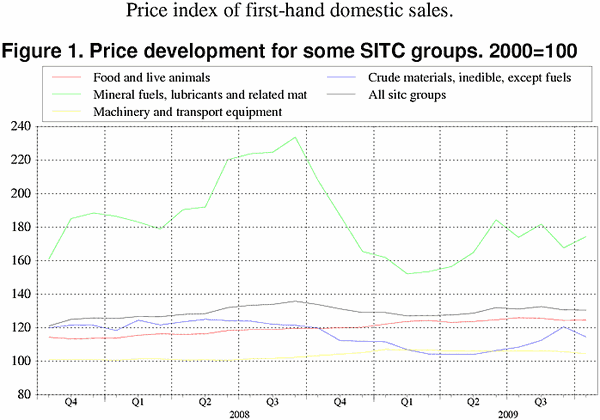Content
Published:
This is an archived release.
Lower prices of crude materials
The price index of first-hand domestic sales fell by 0.2 per cent from September to October. The main reason for this drop is lower prices of crude materials, inedible, except fuels. Higher prices of electricity tempered the total drop in the overall index.
The price index of first-hand domestic sales continued downwards from September to October. The decline in the overall index is mainly due to a drop in prices of crude materials, inedible, except fuels, which fell for the first time after five months with increasing prices. Within this group, reduced prices of metalliferous oras and metal scrap, contributed the most to the fall, with a drop of 11.6 per cent.
Lower prices of machinery and transport equipments - down 1.2 per cent - also had a strong influence of the total index. With the exception of a small increase from June to July this year, the prices of machinery and transport equipments has fallen steadily since January 2009, when prices were at their highest point.
Prices of manufactured goods fell by 0.8 per cent from September, mainly due to decreasing prices of non-ferrous metals.
All remaining groups, except food, beverages and tobacco, and mineral fuels, lubricants and related materials, experienced falling prices from September to October. Within the latter group, prices rose by 4.0 per cent, mainly due to higher prices of electricity and petroleum products. A 14.5 per cent increase in the prices of electricity was due to higher power consumption caused by lower temperatures along with falling levels in Norwegian water reservoirs.
Lower import prices due to strong NOK compared to foreign currencies
The Import-weighted krone exchange rate (I-44), measured by the Norwegian central bank, showed an appreciating krone exchange rate from September to October. This may be the main explanation for lower import prices. I-44 is calculated based on the value of NOK compared with the currency of Norway’s 44 most important trading partners.
Still negative 12-month rate
The price index of first-hand domestic sales fell by 2.5 per cent from October 2008 to October 2009. This was mainly due to lower prices of mineral fuels, lubricants and related materials, and electricity. The prices of electricity contributed most to the decline, with a fall of 41.6 per cent. Prices of chemicals and related products fell by 6.0 per cent in the same period, mostly due to lower prices of inorganic chemicals. Both manufactured goods and crude materials influenced the twelve-month rate in a negative direction, with a drop of 2.8 and 4.4 per cent respectively.
| October 2009 | Changes, per cent | ||||||||||||||||||||||||||||||||||||||
|---|---|---|---|---|---|---|---|---|---|---|---|---|---|---|---|---|---|---|---|---|---|---|---|---|---|---|---|---|---|---|---|---|---|---|---|---|---|---|---|
|
September 2009-
October 2009 |
October 2008-
October 2009 |
||||||||||||||||||||||||||||||||||||||
| Total index | 130.5 | -0.2 | -2.5 | ||||||||||||||||||||||||||||||||||||
| Food and live animals | 124.5 | 0.1 | 4.1 | ||||||||||||||||||||||||||||||||||||
| Beverages and tobacco | 136.1 | 0.3 | 7.7 | ||||||||||||||||||||||||||||||||||||
| Crude materials, inedible, except fuels | 114.6 | -5.0 | -4.4 | ||||||||||||||||||||||||||||||||||||
| Mineral fuels, lubricants and related materials | 174.3 | 4.0 | -16.3 | ||||||||||||||||||||||||||||||||||||
| Chemicals and related products, n.e.s | 126.3 | -0.6 | -6.0 | ||||||||||||||||||||||||||||||||||||
| Manufactured goods classified by material | 123.2 | -0.8 | -2.8 | ||||||||||||||||||||||||||||||||||||
| Machinery and transport equipment | 104.5 | -1.2 | 1.1 | ||||||||||||||||||||||||||||||||||||
| Miscellaneous manufactured articles | 108.4 | -0.6 | 2.2 | ||||||||||||||||||||||||||||||||||||
Additional information
Contact
-
Producer price index
E-mail: produsentpris@ssb.no
tel.: (+47) 21 09 40 00
-
Elisabeth Mælum
E-mail: elisabeth.maelum@ssb.no
tel.: (+47) 97 01 28 49
-
Monika Græsli Engebretsen
E-mail: monika.graesli.engebretsen@ssb.no
tel.: (+47) 40 90 23 71
-
Morten Madshus
E-mail: morten.madshus@ssb.no
tel.: (+47) 40 90 26 94

